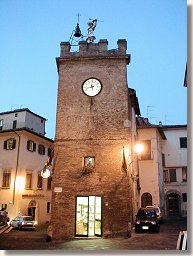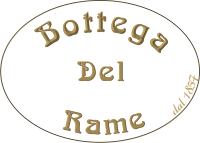Montepulciano

The best way to experience a new town is to see it through the people who live there. Through their eyes you can see all its hidden secrets. So with that in mind, when you come to Montepulciano, come & meet us!
You can see how we craft our copper. Then we can offer you sound advice on where to try the best food & wine in the area!
Your car can be left in lot No. 8 – named 'il bersaglio'. Walk down the small road which leads to the town. Ensure you stop to take in the wonderful view of the valley below. Then take Via del Poliziano on the right. You'll reach Via dell'Opio nel corso. Our shop is No. 64
In the meantime here are some helpful hints about our town:
Our wine: One of the very best red wines in Italy is the Vino Nobile di Montepulciano. The production of this noble wine dates back to ancient times. Thanks to the quality of its hills, the microclimate & industrious farmers, wine making has always ranked highest in the Montepulciano economy. There's even reference to a document dating back to 1350 in the 'Geographical Dictionary of Tuscany' by Repetti. It states the terms for trade & export of Montepulciano wine.
In 1549 Sante Lancerio, chief cellarman of Pope Paolo III Farnese, extolled the high quality of Montepulciano wine calling it 'vino perfectissimo'
In his dithyramb 'Bacchus in Tuscany' dated 1685, Francesco Redi concludes 'Montepulciano of any wine is king'
The production area of Vino Nobile di Monteputciano is limited to the boundaries of the Municipality. Excluding the flat area of Valdichiana & to the lands located between 250 & 600 meters of altitude. The modern growing & selection methods, joined with the ancient skills of master cellar men, produces a wine of excellent quality.
Good food: Tuscany is renowned for the tastefulness of its typical cuisine. In Montepulciano you can find excellent food.
The most typical recipe here is Pici alle Briciole. Its special but has simple ingredients. Pici is the typical pasta of Politians. The ingredients comprise of white flour & water plus a generous injection of a love for food! The sauce is made of Tuscan oil & stale bread. It may seem like an ordinary dish, but in fact it’s far from it! When you taste it’s ancient origins you will be impressed. And it goes perfectly with Montepulciano red wine!
Maccheroni & tagliatini is made with the same ingredients. Pansanella is made with stale bread. It’s a salad dressed with plenty of oil & enriched with spices such as onion & basil. Ribolita is a soup made with sliced bread. It’s perfect if washed down with bean broth. Rivoltolo is made with wheat flour. Its worked & cooked in oil. Ravaggiolo is a soft cheese wrapped in leaves. Bruschetta is made with roasted bread, rubbed with garlic & dressed with oil.
Roast chicken, nana (duck), ocio (goose) porchetta (pork) cooked with salt, garlic & rosemary. Roasted capon, guinea fowl & rabbut are the meats which emigrated from the countryside to the restaurants of the town.
Your dinner will be enriched by tasty appetizers & delicious cakes. Enjoy your meal!
Take a Walk: Mentepulciano is a wonderful little town that gently lies on a hill. It still preserves its Middle Aged & Renaissance imprint.
Visitors will find a medieval town with unaltered evidence of its history. It’s also perfectly organised to allow tourists to be assisted without being suffocated. Montepulciano citizens have been wise enough to create a 'people friendly' environment. Via its ancient line with land & handicraft, Multepulciano is a cultivated destination for intelligent tourism.
Walking along the small roads of the town you can’t help but feel peaceful. Politians are kind people who live a simple life. There are a few souvenir, farm & wine shops. Many of which offer free tasting of their cheese, sausages, jams & not forgetting wines!
Palaces tell you of the economic & local power of the noble families who once lived there. Take a look at Palazzo del Capitano del Popolo. Palazzo Neri Orselli holds the Civic Museum which exhibits a wide collection of paintings. You can admire the Madonna col Bambino by Sano di Pietro in the Cathedral. Sant’Agostino Church was made by Michelozzo. It contains a wonderful crucifix from the 13th century.
The fortress was destroyed & re-built several times. From it there is a picturesque view of the valley. Whilst below S.Biagio Church sits blended architecture by Antonio da Sangallo il Vecchio.
Itinery. Montepuliano is located in Tuscany in the Siena province. It sits 200 km from Rome & 120 km from Florence. It stands on a hill 605 meters high between Valdichiana & Valdorcia. Along with wonderful views it offers a beautiful Mediterranean climate.
Montepulciano gained grandeur & power dating back to the Etruscan age. This power persisted through the first centuries of the second millennium. This was thanks to the clever alliances offered when major towns fought with each other. Montepulciano entered the Florence state in 1511 then counted the 16th century as its ‘great time’. A lot of this was due to the works of famous baroque architects like Sangallo & Vignola.
Coming from the South: toll road A1 Firenze-Roma. Exit Chiuisi-Chianciano Terme then follow SS146 for about 20 km.
Coming from the North: toll road A1 Firenze-Roma, exit Valdichiana then follow SS 326 for about 20 km
Coming from Siena or Perugia: motorway Siena-Bettolle-Perugia.
The main entrance to the town is Porta al Prato in the north. Start climbing via Gracciano nel Corso bordered by noble buildings such as Palazzo Avignonesi & Palazzo Cocconi. On the right sits the church of S. Agostino which dates back to the 15th century. Passing by the Piazza delle Erbe take Via Voltaia nel Corso & look at the fine palaces & chiesa del Gesu. You’ll then be in the Via Opio nel Corso. Take a detour through the little roads on the left. Going down to the belvedere is a stunning view of the whole valley.
Go back to Via Opio nel Corso. You will find our shop at No. 64. The workshop is on the road behind in Via del Teatro. If you haven’t already dropped by then stop in to have a chat with us.
Continuing on Via Opio nel Corso you will find the home of Poliziano on the left. He was one of the main poets of the first Renaissance. If you follow Via del Poliziano you will reach the church of S. Maria dei Servi. On your way back Via San Donato climbs round the fortress taking you to the wonderful Piazza Grande. This is the town center & sits at the very top of the hill. You should stop to admire its beauty. It offers some of the main monuments in the town. The Duomo from the late Renaissance & the palazzo Comunale from the 14th century.
The Civic Museum is reached via Via Ricci. It exhibits a valuable collection of paintings from the 13th – 17th century. Back to the starting point you will also see the churches of S. Francesco from the 13th century & S. Lucia – baroque. You shouldn’t miss the church of S. Biagio which is one of the most important creations of Renaissance. It was a masterpiece by Antonio da Sangallo il Vecchio. It can be reached by car if you take the ring road in the direction of Chianciano then turn right to Viale delle Rimembranze.
If you decide to visit this beautiful medieval city in the second half of August, you will find it in great turmoil because the last Sunday of August, all districts will compete in Bravìo delle Botti.
The city is adorned with the colors of the contrada and all contradaioli are working for the event.

